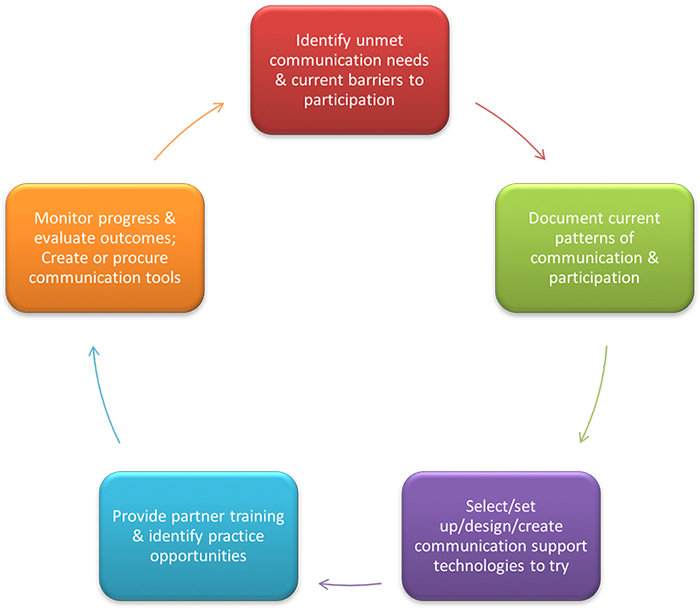Working in inter-professional teams, Bridge School staff use the Participation Model (Beukelman & Mirenda, 2013) to guide the process of AAC system development and assess appropriate communication tools for each student. Students with SSPI and CCN learn to use a range of communication support technologies to meet daily communication needs. Taken together, these tools, and the strategies for how and when to use them across interactions, make up an individual’s AAC System.
The team assesses current functional participation relative to typical participation patterns of same-aged peers, as well as current barriers to communication and full participation in school activities. This includes an assessment of the student’s motor, linguistic, literacy, and sensory/perceptual skills and levels of current functioning in the school environment. (See section on Assessment: Documenting Present Levels of Performance, setting goals, and monitoring progress.) We consider a variety of communication support technologies and then test these possible tools and strategies in different situations to determine if they are effective at meeting specific communication needs. We teach the student to use those tools and strategies within classroom activities and meaningful social interactions. The team identifies the best times to provide multiple practice opportunities across the student’s day, and trains important communication partners and facilitators. We establish processes for monitoring progress and evaluating outcomes. Selection of communication support technologies and teaching strategies are modified as needed until effective communication tools/strategies are identified. If a commercially-available device is deemed an appropriate tool to meet the student’s current communication needs and increase effective participation, we work together with families to proceed with the funding and procurement process. This assessment process is repeated as the team identifies additional unmet communication needs and opportunities to maximize participation.

The Bridge School’s assessment process for communication support technologies. The communication needs of the student inform the selection/creation/procurement of AACsystem components, rather than a particular device or tool leading the assessment process.
We view AAC system development as a dynamic, ongoing process. AAC systems are continually evolving to meet a student’s changing needs and abilities. An AACsystem is unique to each student and may include some or all of the following communication support technologies:
We view AAC system development as a dynamic, ongoing process. AAC systems are continually evolving to meet a student’s changing needs and abilities. An AACsystem is unique to each student and may include some or all of the following communication support technologies:
In the United States, funding models for communication support technologies, including speech-generating devices (SGDs), is locally regulated by individual states and school districts. As mainstream technologies become a more essential part of users’ AAC systems, funding models are increasingly in flux and laws are changing rapidly. Funding sources may include primary medical insurance, Medicare insurance, school district funding or, in many cases, privately funded by families. Below are some general resources for SGD funding.
Roles and Responsibilities of Speech-Language Pathologists With Respect to Augmentative and Alternative Communication: Technical Report.
ASHA Special Interest Division 12: Augmentative and Alternative Communication (AAC) http://www.asha.org/policy/TR2004-00262/#sec1.7
Guidelines for Meeting the Communication Needs of Persons with Severe Disabilities
National Joint Committee for the Communication Needs of Persons with Severe Disabilities http://www.asha.org/policy/GL1992-00201/
National Joint Committee for the Communication Needs of Persons with Severe Disabilities (NJC) http://www.asha.org/NJC/
Beukelman, D. & Mirenda, P. (2013). Augmentative and Alternative Communication: Supporting children and adults with complex communication needs. Fourth Ed. Baltimore: Paul H. Brookes Publishing Co.